 |
|
|
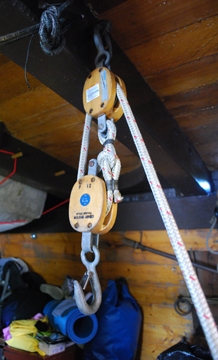
Mechanical advantage is the ratio of output force divided by input force in a simple machine, such as a pulley, lever, or winch. The greater a machine's mechanical advantage, the greater its output force compared to its input force. In other words, simple machines with positive mechanical advantage make it easier to lift or move heavy objects.
|
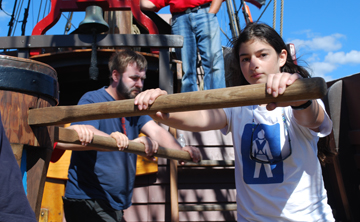
We use simple machines all over the Half Moon in a wide variety of forms and uses. For example, our capstan is a massive winch used for tasks such as weighing anchor. The anchor alone weighs over 400 lbs., while the total load on the capstan (including the anchor, chain, line, and the strain of pulling the ship against the current) while weighing anchor can approach a ton. Despite this, with the capstan's help, just eight students can raise our anchor without a problem (though certainly not without effort!).
|
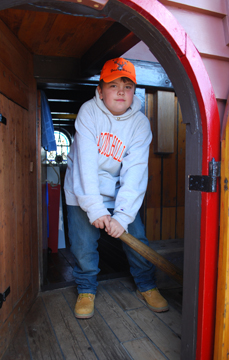
In the helm hutch, we use a whipstaff (pictured) to steer the ship; the original Half Moon predates wide use of the ship's wheel by about a century. The whipstaff is a simple lever, allowing a single crewmember to easily push the ship's massive rudder and tiller to back and forth.
Above the ship, we use dozens of blocks (pulleys) in the rigging to handle the sails. The lateen sail, our simplest sail, uses more than twenty by itself!
On this leg of the voyage, two research teams studied individual (but related) aspects of mechanical advantage for their presentation projects.
|
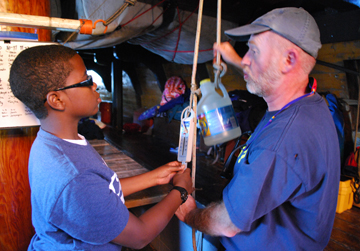
For our experiments in mechanical advantage, we rigged a block-and-tackle system to lift a bottle of water (seen to the right) a fixed distance off the deck, using from one to four pulleys to distribute the load. As we added moveable pulleys, one research team (Colton, Jacob, Jerryangelo, and Mylah) used a spring scale to measure the decreasing amount of force needed to lift the water bottle.
Conducting their own series of experiments, the second research team (Courtney, Ellie, Lilly, and Tahjah) then measured the increasing length of line they needed to pull through the system in order to lift the bottle. As this distance increased, they witnessed conservation of work.
|
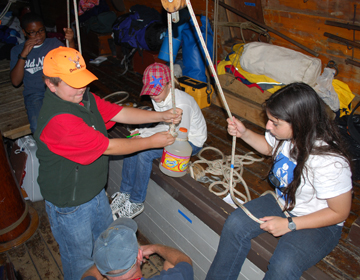
In theory, each moveable (as opposed to fixed) pulley doubles this simple machine's mechanical advantage. In practice, however, the friction of the lines and pulleys counteract this advantage. The effect of friction is negligable at first, but it gradually increases as more pulleys are added, ultimately canceling out any mechanical advantage gained — thus placing limits on the machine's effectiveness, no matter how many additional pulleys are added.
|
|
|

